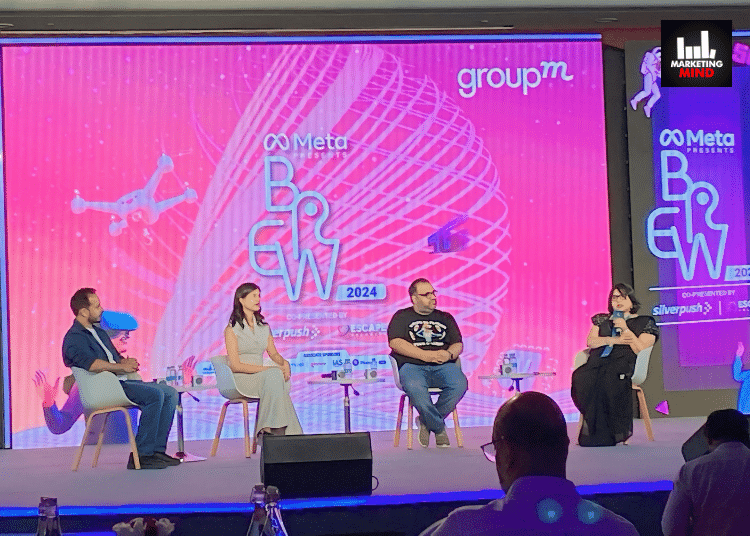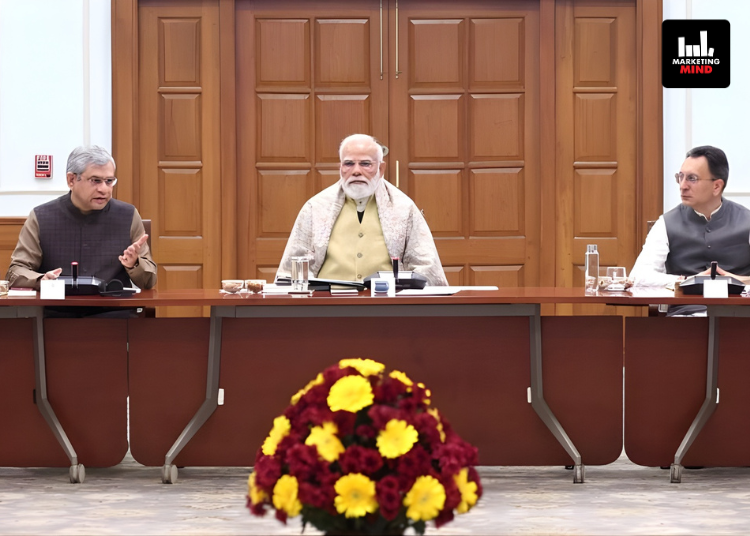In the era of conscious influence, consumers and brands are increasingly aware of the impact of their choices on the environment and society. This shift reflects a broader trend towards sustainable living and responsible consumption, where individuals and companies alike seek to align their actions with values that promote well-being, ethical practices, and environmental stewardship.
This movement challenges traditional marketing and consumer behavior, requiring a deeper understanding of the psychological triggers that drive decision-making. As brands navigate this evolving landscape, considering not only the appeal of their products but also the narratives that resonate with a conscientious audience becomes crucial, ultimately fostering a more mindful and responsible marketplace.
In GroupM‘s seventh edition of the annual event ‘Brew’ held on Wednesday in Gurugram, a panel discussion, named ‘The Era of Conscious Influence: Notes for Brands’ brought together industry players and influencers to delve into these themes.
The panel featured Dr. Sid Warrier, influencer; Sejal Kumar, influencer and actor; Utsav Malhotra, COO of Noise, and Mausumi Kar, Managing Director of Motivator, who explored the dynamics of conscious influence and its implications for brands and consumers.
Kar began with explaining the United Nations’ declaration on sustainability. In 2015, the UN adopted 17 Sustainable Development Goals (SDGs). While India struggles significantly with 16 of these goals, it excels in one – SDG 12, which focuses on responsible consumption and production.
India’s performance in this area stands out positively, not just in comparison to developed economies, but also among emerging economies, she mentioned.
Furthermore, she emphasised, “The world’s eyes are on India, questioning whether our high ranking on SDG Goal 12 is due to mere luck or if we are genuinely implementing effective practices. So, the questions arise if we are witnessing a significant shift in our consumption patterns? Are structural changes in our physical, mental, and emotional well-being influencing the types of products we use? Is there a growing emphasis on health and fitness? Are we producing more traditionally, or have we embraced new-age practices?”
“It is commonly believed that advertising can only do so much, and to achieve genuine behavioural change, like altering consumption habits, a certain amount of nudge is required. The idea of a nudge indicates that to spark real change, specific triggers must be activated in the brain,” she said.
Adding on to Kar’s point, Warrier elaborated that when making a purchase decision, the actual choice is often made several seconds to minutes before the purchase button is clicked. This decision process involves two parts of the brain: the limbic system, which functions as the primitive or reptilian brain, and the prefrontal cortex, which represents the evolved brain. In simple terms, this is the contrast between the old brain and the new brain.
“The limbic system is responsible for making purchasing decisions, determining whether to engage with or avoid something. The prefrontal cortex’s role is to rationalise the decision that the limbic system has already reached. Thus, when discussing conscious influence or conscious capitalism, the prefrontal cortex primarily crafts a narrative to justify choices that our emotions have already dictated,” he said.
“When we talk of India and how our behaviour has been over the years, social parameters have played a very big role in that core identity. There is definitely a shift now because of the kind of content that we see. The nudge that we talk about happens slowly and there is a gradual shift in the emotional level of our consumers which takes place over months to years. So any shift that happens in capitalism or consumerism happens at the limited level and the prefrontal cortex has a job of justifying those decisions,” he added.
When asked about how brands can impact the limbic brain and whether there are specific strategies to discuss, Warrier emphasised two key points. First, the brain does not differentiate between content and advertisements, this distinction is a construct of the prefrontal cortex. To the brain, both are simply information. We impose the separation between content and ads, such as clearly distinguishing between them during a cricket match.
However, he pointed out that with the advent of social media, this distinction is becoming increasingly blurred. In the limbic system, which never saw a difference, even the prefrontal cortex now struggles to distinguish when content ends and ads begin. This blurring effect allows more of the brain to engage with the information.
“Therefore, one effective strategy is to blur these lines further. The second point is that the brain does not recognise brands per se, but rather focuses on self-identity,” Warrier said.
“When consumers encounter a brand online, they inevitably relate it to their own self-image. Whether a brand is perceived as good or bad is often evaluated in terms of how it reflects on the consumer. They consider how they would look or feel in association with the brand. Therefore, every brand relationship essentially becomes a journey of self-identity. Thus, brand consciousness is intrinsically linked to the consumer’s self-consciousness,” he added.
Kumar, chosen in 2020 as one of the creators, globally, in the YouTube Creators for Change program alongside Michelle Obama, shared insights into her unique perspective as both an influencer and a consumer.
“I began my journey as a teenager in this space, and naturally, I’ve evolved significantly as a person. Throughout my journey, I have become a strong advocate for gender equality in all aspects of my life. I avoid making any aggressive statements on my platform. If I ever say something inappropriate, I take that feedback seriously and strive to improve. This is something I believe all creators should consider, as our audiences absorb a lot from us,” Kumar said.
Kumar mentioned that this approach has led to many organic opportunities, including a project with Michelle Obama focused on girls’ education. She created a beautiful song for this project, her first, presented like a short film, emphasising the importance of starting girls’ education at home.”
“After attending a YouTube conference, where I was invited, I realised the significant impact of my content. Previously, I focused on creating fashion-centric content, like “six seconds, six outfits”. This experience made me reconsider and step back from producing such examples, allowing me to take on more responsibility in what I share,” she added.
Meanwhile, Malhotra mentioned that Noise didn’t initially aim to establish itself as a cool tech brand in India. It began as a brand with a mission, and as it resonated with the youth, it evolved into a channel for their self-expression, eventually gaining that perception.
Kar asked Malhotra, “The concerns surrounding well-being and health are widely discussed by everyone. In our country, there’s often a lack of emphasis on prevention, people typically seek medical help only after something goes wrong. However, there’s a growing awareness by brands like yours, that we need to be more proactive about our health. Now, when we hear a lot about sustainable technology, how are you adopting that and what are the challenges and opportunities in these areas?”
Malhotra elaborated, “Our conditioning has led us to develop certain beliefs that justify our actions and shape how we live. When discussing consciousness, it’s about reflecting what resonates with us. As marketers, our role involves using spaced repetition to penetrate this conditioning. By consistently delivering a particular message, we can subtly influence core perceptions, as the brain doesn’t distinguish. The real dilemma arises when deciding between what’s morally right and what’s commercially effective, a challenge that brands and businesses often face.”
Furthermore, he went on to say that as a brand, Noise began differently than what it is now. Many may not know this, but in its current form, the brand aims to inspire Indians by democratising connected lifestyle tech. These words may seem like mere jargon, but they represent the brand’s commitment to building access and fundamentally impacting lives.
“We don’t dictate whether someone buys a product to start a fitness journey. We set goals and define various consumer journeys, but we don’t intend to preach a specific behaviour. It’s ultimately the consumer’s choice, although we can guide them toward adopting beneficial behaviours,” Malhotra said.
He also highlighted that Noise, as a brand, currently has a market penetration that’s a quarter of what the US and China have achieved.
“We are still trailing in terms of adoption rates. Even though we’re a young and tech-savvy nation, there are still some who are hesitant to embrace new technologies. To address this, we modify our communication strategy to connect on an emotional level and highlight the benefits. This approach helps the conscious mind justify investing in something like fitness,” Malhotra said.
“We have successfully executed this strategy in the past, showing that adopting a conscious lifestyle is a choice both brands and consumers can make. Finding a balance has been key to our success, and it’s this balance that has helped us gain a foothold in the market. As a result, we have positioned ourselves as the third-largest smartwatch company globally, thanks to our success in India,” he added.
Malhotra pointed out that the main challenge lies in overcoming consumer inertia, where they are subtly trying to influence human behaviour towards business capitalisation. It’s essential to create the right incentives.
“Currently, our platform, which hosts around 1 million active users daily, promotes virtual marathons. We advocate for a healthy lifestyle, allowing users to participate at their own pace, without the pressure of competition. There are ample incentives to encourage this behaviour. We have partnerships with insurance companies, card services, and wellness products. Two years ago, we launched a product with an SBI Card that rewards healthy behaviour with monetary benefits. This has become the best-selling paid product in the country,” he added.
In conclusion, Malhotra said that the key takeaway is that brands must continuously find new ways to engage consumers. Brands today are more passive due to shorter attention spans, which means engagement needs to be even more compelling.
















